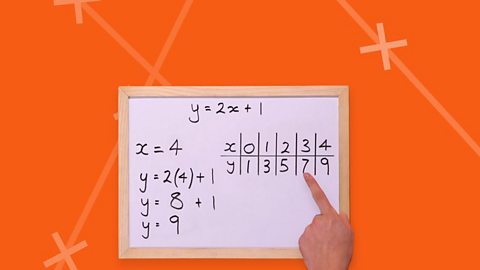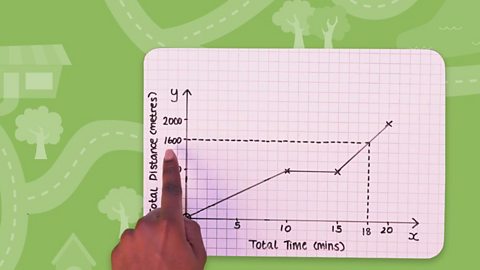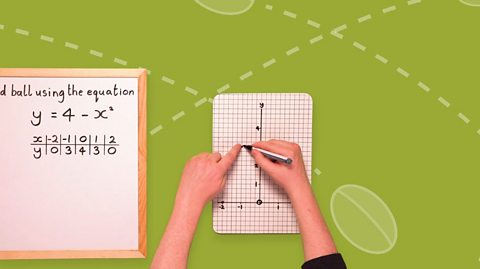Horizontal and vertical lines (in the form y = c and x = c)
Plotted points on a graph are referred to as coordinates.
Coordinates are pair of numbers written in the form \(({x},~{y})\) where \({x}\) is the amount moved horizontally, and \({y}\) the amount moved vertically from the origin on a graph.
The two values are referred to, in order, as the \({x}\)-coordinate and the \({y}\)-coordinate.
Graphs of the form \({y} = {c}\) and \({x} = {c}\), will either be a horizontal or vertical line.
y = c
Example
All the points on the horizontal line below have a y-coordinate of \(4\), so you can say that the equation of the line is \(y = 4\).
x = c
Example
All the points on the vertical line below have an x-coordinate of \(7\), so you can say that the equation of the line is \(x = 7\).
Graph forms
All vertical line graphs have an equation of the form:
\(x = c\)
For example:
\(x = 1\), \(x = -3\), \(x = 4\), etc
All horizontal line graphs have an equation of the form:
\(y = c\)
For example:
\(y = 3\), \(y = -2\), \(y = 1\), etc.
If you are unsure whether the equation of the line is of the form \(x = …\) or \(y = …\), find the coordinates of at least two points on the line.
If the \(x\)-coordinates are the same, the equation of the line will be of the form \(x = …\).
If the \(y\)-coordinates are the same, the equation of the line will be of the form \(y = …\).
Equations of other straight line graphs
The equation of a straight line on a graph is made up of a \(y\) term, an \(x\) term and a number, and can be written in the form of \(y = mx + c\).
- The slope of the line is known as the gradient and is represented by the value of \(m\) in the equation.
- The point at which the line crosses the \(y\)-axis is the value of \(c\) in the given
equation, and is referred to as the \(y\)-intercept.
For a line with equation \({y}={2}{x}+{4}\):
\({m}={2}\) so the gradient of the line is \({2}\).
\({c} = {4}\) so the line will cut the \({y}\) axis at \({4}\).
Question
What is the gradient of the line with the equation \({y}={3}x{-2}\)?
Answer
\({m}={3}\) so the gradient is \({3}\).
Question
Where does the line \({y}={3}x{-2}\) intersect with the \(y\) axis?
Answer
\({c}={-2}\) so the line will cut the \({y}\) axis at \(-2\).
All the points that lie on the green line have a \(y\)-coordinate that is the same as the \(x\)-coordinate, eg:
\(({-1},~{-1})\) and \(({2},~{2})\)
We say that the equation of the line is \(y = x\).
All the points that lie on the purple line have a \(y\)-coordinate that is one number higher than the \(x\)-coordinate of the same line, eg:
\(({-3},~{-2})\) and \(({0},~{1})\).
In other words, the \(y\)-coordinate equals the \(x\)-coordinate \(+ 1\).
So the equation of the line is \(y = x + 1\).
Question
What is the equation of the line shown below?
Answer
The coordinates of the points are \(({2},~{4})\), \(({1},~{2})\) and \(({-2},~{-4})\).
Here, the \(y\) value is always twice the \(x\) value.
The equation of the line that fits these \(x\) and \(y\) values is:
\(y = 2x\)
Test yourself
Question 1
What kind of line is \({y}={6}\)?
Answer
If \({y}={6}\), \({(0,~6)}\), \({(1,~6)}\) and \({(2,~6)}\) are on the line, so it's horizontal.
Question 2
What kind of line is \({x}={-5}\)?
Answer
If \({x}={-5}\), \({(-5,~0)}\), \({(-5,~1)}\) and \({(-5,~2)}\) are on the line, so it's vertical.
Question 3
What is the equation of the line that goes through points \({(0,~0)}\), \({(1,~3)}\), \({(2,~6)}\)?
Answer
The \({y}\)-coordinate is three times greater than the \({x}\)-coordinate every time, so \({y}={3}{x}\).
Question 4
What's the gradient of a line whose equation is \({y}={7}{x}-{3}\)?
Answer
If an equation takes the form of \({y}={m}{x}+{c}\), the \({m}\) value is the gradient.
Here the value of \({m}\), namely the gradient, is \({7}\) and the value of \({c}\) is \({-3}\).
Question 5
What's the gradient of a line whose equation is \({y}={-2x}+{5}\)?
Answer
If an equation takes the form of \({y}={m}{x}+{c}\), the \({m}\) value is the gradient.
Here the value of \({m}\), namely the gradient, is \({-2}\) and the value of \({c}\) is \({5}\).
Question 6
What's the value of \({y}\) when the line \({y}={-4}{x}+{1}\) intersects the \({y}\)-axis?
Answer
The intersection of \({y}\) is the value \({c}\) in the equation \({y}={mx}+{c}\).
In the equation \({y}={-4x}+{1}\) we clearly see that the value of the \({y}\) intersection is \({1}\).
Question 7
What's the value of y when the line \({y}={5x}-{2}\) intersects the \({y}\)-axis?
Answer
The intersection of \({y}\) is the value \({c}\) in the equation \({y}={m}{x}+{c}\).
In the equation \({y}={5}{x}-{2}\) we clearly see that the value of the \({y}\) intersection is \({-2}\).
Question 8
What's the value of \({y}\) when the line \({2y}={6x}-{8}\) intersects the \({y}\)-axis?
Answer
The intersection of \({y}\) is \({c}\) in the equation \({y}={mx}+{c}\), so you need to divide each side by \({2}\) to get \({y}={3x}-{4}\).
This clearly shows the value of the \({y}\) intersection is \({-4}\).
More on Straight line graphs
Find out more by working through a topic
- count3 of 8

- count4 of 8

- count5 of 8
